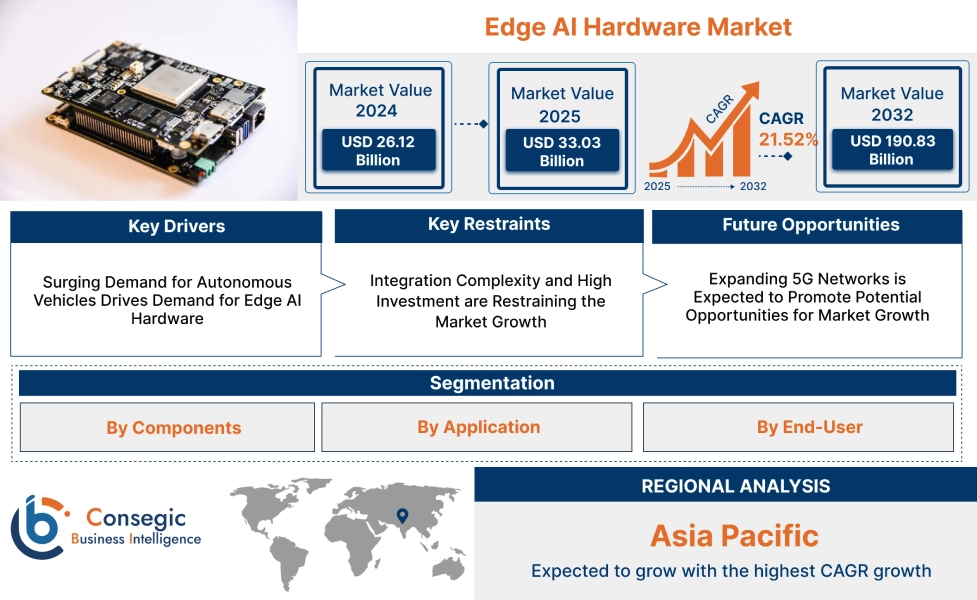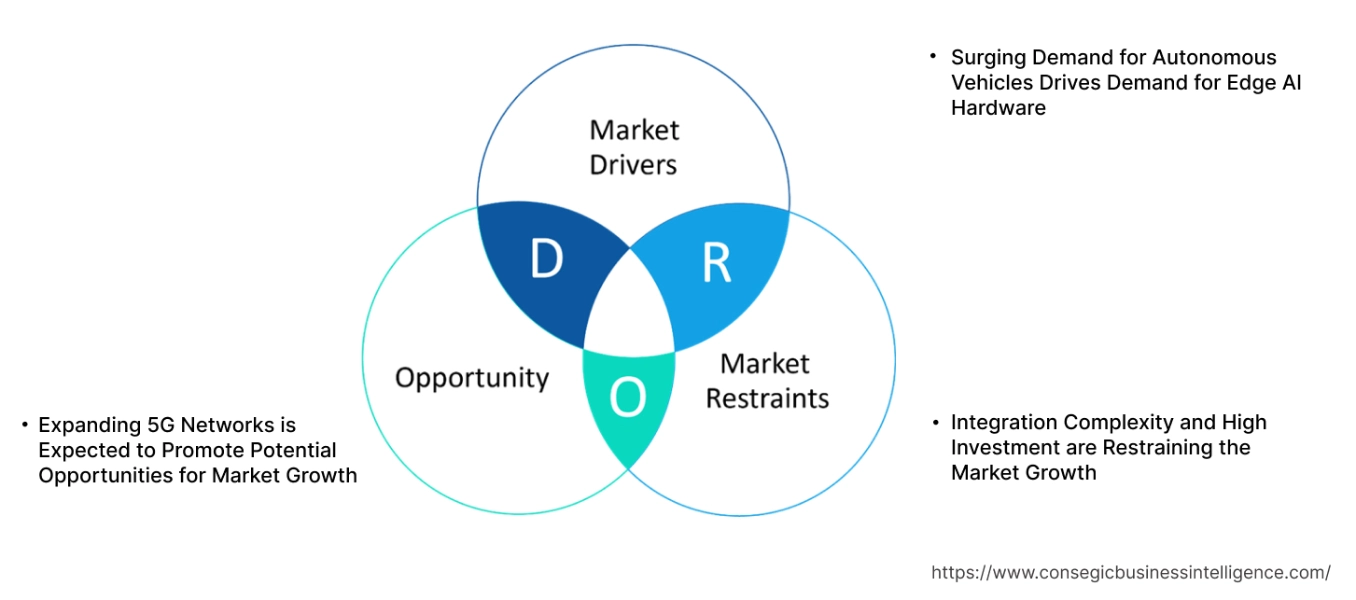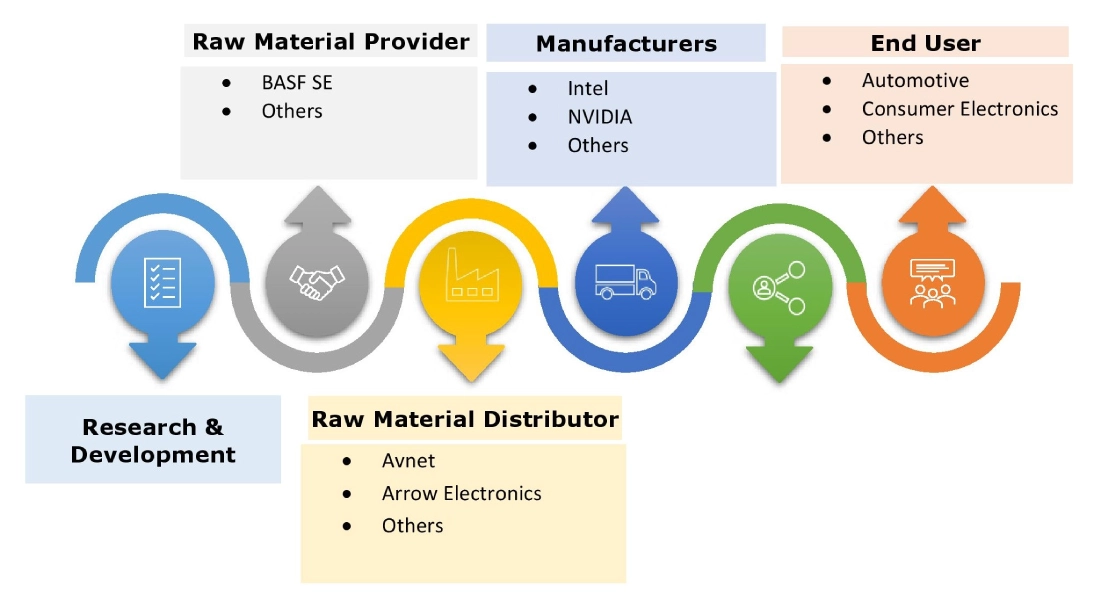Edge AI Hardware Market Size:
Edge AI Hardware Market size is estimated to reach over USD 190.83 Billion by 2032 from a value of USD 26.12 Billion in 2024 and is projected to grow by USD 33.03 Billion in 2025, growing at a CAGR of 21.52% from 2025 to 2032.
Edge AI Hardware Market Scope & Overview:
Edge AI hardware refers to specialized computing devices that deploy AI algorithms and AI models directly on local edge devices, eliminating the need for cloud servers. The hardware components include CPU, GPU, and others, which help to balance performance, power efficiency, and cost to handle various tasks such as speech processing, image recognition, and others. Additionally, the key advantages, including enhanced speed, privacy, and cost-effectiveness, are driving the Edge AI Hardware Market growth. Further, the growing adoption of smartphones and industrial automation is driving the Edge AI Hardware Market demand. Furthermore, the increasing importance of data security and reduced dependency on cloud-based infrastructure is boosting the edge AI hardware industry.
How AI is Impacting the Edge AI Hardware Market?
AI is significantly impacting the market by enabling edge devices to process data locally, reducing reliance on cloud infrastructure, minimizing latency, and improving response times. Additionally, AI allows for faster and more efficient decision-making in applications such as autonomous vehicles, industrial automation, and smart surveillance. Moreover, the need for real-time data analysis is driving the adoption across industries. Further, the growing emphasis on developing energy-efficient hardware to support edge AI. Furthermore, AI helps to reduce latency and bandwidth requirements, eliminating the need for cloud-based processing.
Edge AI Hardware Market Dynamics - (DRO) :
Key Drivers:
Surging Demand for Autonomous Vehicles Drives Demand for Edge AI Hardware
The autonomous vehicles rely on AI for processing data from cameras, LiDAR, and radar in real-time, which in turn is boosting the Edge AI Hardware Market demand. The hardware enables quick decisions, eliminating the need for cloud-based processing, ensuring safety and reliability on the road is driving the Edge AI Hardware Market growth. Further, edge AI minimizes latency by processing data on the vehicle itself, improving safety and performance which results in market progress.
- For instance, in July 2025, Pony AI Inc. collaborated with Dubai's Roads and Transport Authority to launch Robotaxi, which is an advanced L4 autonomous mobility solution. Also, the company has received approval to launch Robotaxi in the United States, China, South Korea, and Luxembourg.
Therefore, the rising adoption of self-driving vehicles is driving the adoption of edge AI, in turn, proliferating the growth of the market.
Key Restraints:
Integration Complexity and High Investment are Restraining the Market Growth
Edge devices range widely in processing power, memory, and operating systems, demanding compatibility and optimization across platforms is hindering the Edge AI Hardware Market expansion. Additionally, the lack of standardized protocols and data formats makes seamless communication between diverse edge devices and existing infrastructure challenging, which in turn is restraining the market's progress. Further, Edge AI requires dedicated hardware such as AI chips or accelerators, which increases initial capital expenditure is creating a barrier for market adoption.
Therefore, the high costs and integration complexity are hindering the Edge AI Hardware Market expansion.
Future Opportunities :
Expanding 5G Networks is Expected to Promote Potential Opportunities for Market Growth
The expansion of 5G networks is expected to boost edge AI capabilities by offering fast, reliable connectivity, which is required for large-scale, real-time AI processing is propelling the Edge AI Hardware Market opportunities. Further, the rising adoption of edge AI across industries is creating smarter, more efficient, and secure solutions for a wide range of applications is paving the way for market progress.
- For instance, according to 5G Americas, 5G connections are expected to reach 2.25 billion worldwide in 2024. Also, North America dominated with 289 million 5G connections, representing a 67 percent year-over-year increase at the end of 2023.
Hence, the rising adoption of 5G networks is anticipated to increasethe utilization of edge devices, in turn promoting prospects for Edge AI Hardware Market opportunities during the forecast period.
Edge AI Hardware Market Segmental Analysis :
By Components:
Based on the components, the market is segmented into CPU, GPU, FPGA, ASIC, microcontrollers, and others.
Trends in the Components:
- The proliferation of IoT devices is driving the adoption of GPUs, which in turn is boosting the edge AI hardware market trends.
- The rise of smaller, optimized AI models is propelling the need for high-performance CPUs, which in turn is boosting the Edge AI Hardware Market trends.
The CPU component accounted for the largest revenue share in the year 2024.
- The growing need for energy-efficient hardware solutions to extend battery life and reduce power consumption is driving the demand for CPU components, thereby fueling the Edge AI Hardware Market size.
- Additionally, the proliferation of IoT and the need for real-time data processing are driving the need for CPU, which in turn is boosting the Edge AI Hardware Market share.
- Further, the ability of CPUs to handle various AI tasks, from smartphones to industrial IoT devices, makes them crucial for edge AI deployments, driving the Edge AI Hardware Market share.
- Thus, according to the Edge AI Hardware Market analysis, the proliferation of IoT and the need for real-time data processing are driving the market progress.
The GPU component is anticipated to register the fastest CAGR during the forecast period.
- GPU plays a crucial role in industries with data security and latency concerns which in turn need on-premises processing.
- Additionally, the key advantages of GPUs include enhanced performance and speed, improved efficiency and resource utilization, enhanced security, and privacy, among others.
- Further, GPUs improves response times, enhances cloud-based processing, and ensures data privacy, which in turn boosts the Edge AI Hardware Market size.
- Therefore, as per the market analysis, the rising focus on reducing reliance on cloud-based processing is anticipated to boost the market during the forecast period.
By Application:
Based on the application, the market is segmented into smartphone, smart home appliances, industrial robots, autonomous vehicles, wearable health monitoring devices, industrial sensors, and others.
Trends in the Application:
- The trend towards increasing focus on reducing electricity consumption is driving the integration of Edge AI capabilities into smart lighting systems that adjust automatically.
- The trend towards the need for faster processing and reduced latency provides quicker responses to potential accidents or obstacles is driving the integration into autonomous vehicles.
Smartphone accounted for the largest revenue share of 36.30% in the year 2024.
- The widespread usage and high level of AI integration, as well as the proliferation of intelligent IoT devices, are driving the market adoption.
- Additionally, increasing internet access is paving the way for integrating edge AI hardware into the smartphones.
- Further, the increasing demand for real-time data processing is driving the market adoption in smartphones.
- For instance, in July 2025, Liquid AI launched the Edge-AI Platform for deploying AI capabilities into smartphones, laptops, wearables, drones, cars, and other devices.
- Thus, according to the Edge AI Hardware Market analysis, the increasing need for real-time data processing is driving the market trends.
Smart Home Appliances is anticipated to register the fastest CAGR during the forecast period.
- The proliferation of IoT devices in homes is fueling the need for edge AI hardware that can process data locally.
- Additionally, the need for low-latency services is driving the integration of hardware into smart home appliances.
- Further, the smart home appliances such as smart thermostats, security cameras and surveillance, HVAC systems, and smart lighting, among others, are increasingly being integrated with AI capabilities to make homes more comfortable.
- Therefore, as per the market analysis, the need for low-latency services is anticipated to boost the growth of the market during the forecast period.

By End User:
Based on the end user, the market is segmented into consumer electronics, healthcare, automotive, logistics & transportation, aerospace & defence, and others.
Trends in the End User:
- The trend toward a surge in wearable medical devices with low latency, high security is boosting the market adoption in the healthcare sector.
- The trend towards the need for real-time tracking and route optimization is propelling the market adoption in the logistics & transportation sector.
Consumer Electronics accounted for the largest revenue share in the year 2024.
- The increasing need for real-time, on-device processing in consumer electronics is driving the market adoption.
- Additionally, the rapid development of the Internet of Things (IoT) across various sectors, including smart homes, wearables, and others, is boosting the market progress.
- Further, the key factors driving the market adoption in the consumer electronics sector include the proliferation of connected devices, the need for reduced latency and bandwidth usage, and a growing emphasis on data privacy and security.
- For instance, according to IBEF, the FDI in appliances and consumer electronics (ACE) industry has increased from USD 198 million in 2021 to USD 481 million by June 2022, paving the way for market adoption.
- Thus, as per the market analysis, the aforementioned factors are driving the market progress.
Automotive is anticipated to register the fastest CAGR during the forecast period.
- The rising development of autonomous driving and ADAS (Advanced Driver Assistance System) is boosting the integration of Edge AI capabilities into the automotive sector.
- Additionally, the need for real-time decisions in autonomous vehicles, as well as the growing popularity of connected vehicles, is paving the way for market adoption.
- Further, the increasing focus on improving the in-vehicle experience with voice and gesture control is boosting the market progress.
- Therefore, as per the market analysis, the increasing focus on improving the in-vehicle experience is anticipated to boost the market during the forecast period.
Regional Analysis:
The regions covered are North America, Europe, Asia Pacific, Middle East and Africa, and Latin America.
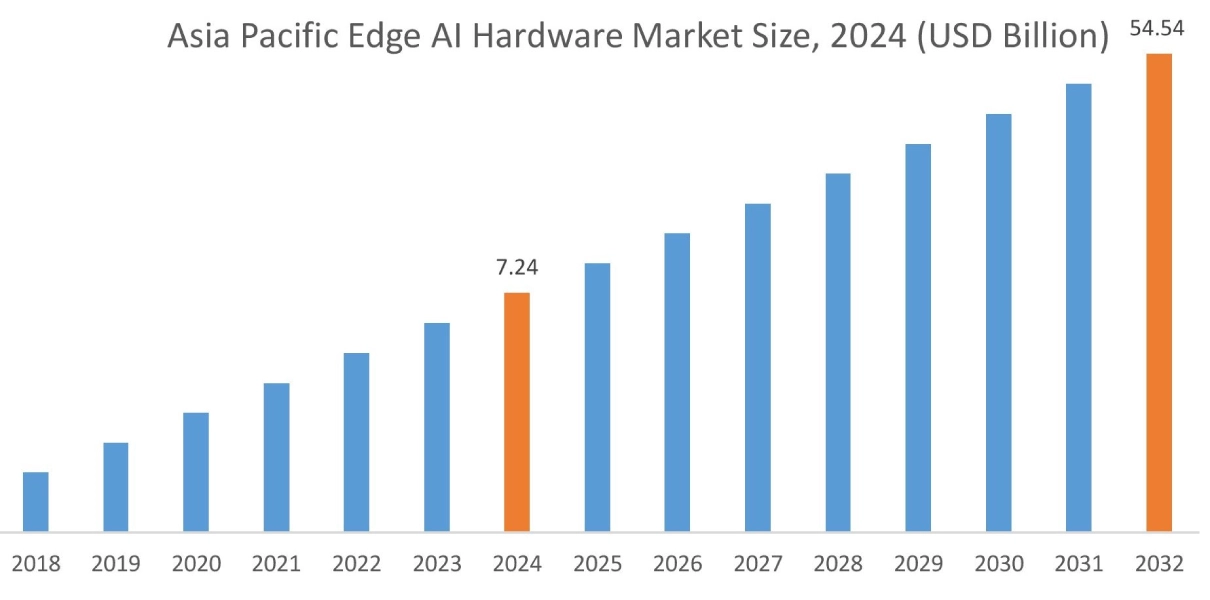
Asia Pacific region was valued at USD 7.24 Billion in 2024. Moreover, it is projected to grow by USD 9.19 Billion in 2025 and reach over USD 54.54 Billion by 2032. Out of this, China accounted for the maximum revenue share of 27.81%. The market progress is mainly driven by the increased adoption of IoT devices. Furthermore, factors including the rising investments in AI-driven technologies are projected to drive the market growth in the Asia Pacific region during the forecast period.
- For instance, in May 2024, EdgeCortix Inc. launched a next-generation edge AI solution for driving advanced AI applications. Also, the applications include super-resolution capabilities, multi-camera analysis solutions, and others.
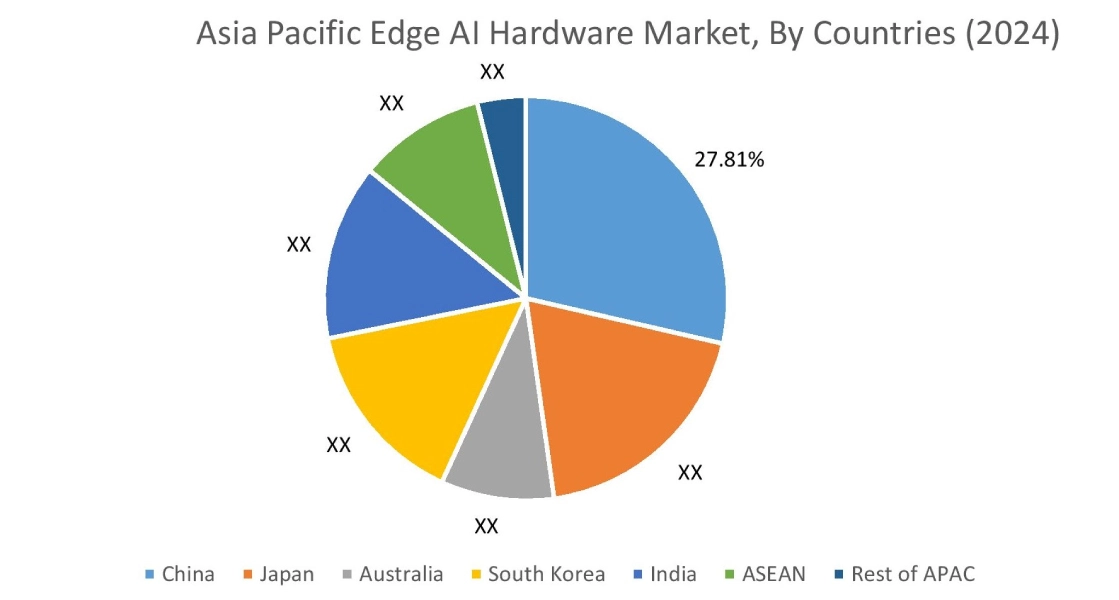
North America is estimated to reach over USD 62.13 Billion by 2032 from a value of USD 8.44 Billion in 2024 and is projected to grow by USD 10.68 Billion in 2025. The North American region's ongoing advancement in high-performance hardware capabilities offers lucrative growth prospects for the market. Additionally, the growing smart infrastructure and proliferation of consumer electronic devices are driving the market progress.
- For instance, in June 2025, Lattice Semiconductor partnered with NVIDIA to leverage the NVIDIA Edge AI Solution. The platform aims to deliver a flexible, full-stack platform for real-time data acquisition and processing.
The regional analysis depicts that the rising investment in Industry 4.0 initiatives is driving the market in Europe. Additionally, the key factor driving the market is the growing focus on real-time data processing in healthcare, as well as the rising adoption of IoT devices is propelling the market adoption in the Middle East and African region. Further, the miniaturization of hardware and the integration of edge AI into various sectors such as manufacturing, healthcare, and retail are paving the way for the progress of the market in the Latin American region.
Top Key Players and Market Share Insights:
The global Edge AI Hardware Market is highly competitive with major players providing edge AI hardware to the national and international markets. Key players are adopting several strategies in research and development (R&D), product innovation, and end user launches to hold a strong position in the edge AI hardware industry. Key players in the Edge AI Hardware Market include-
- NVIDIA Corporation (USA)
- IBM (USA)
- Graphcore (UK)
- Samsung (South Korea)
- Applied Brain Research, Inc. (Canada)
- Microsoft (USA)
- MediaTek Inc. (Taiwan)
- Intel Corporation (USA)
- Meta (USA)
- Horizon Robotics (China)
Recent Industry Developments :
Partnerships & Collaborations
- In June 2025, GlobalLogic Inc. collaborated with the AI-RAN Alliance. The collaboration aims to advance the integration of artificial intelligence (AI) into radio access network solutions, shaping the future of wireless connectivity, intelligence, and sustainability.
Edge AI Hardware Market Report Insights :
| Report Attributes | Report Details |
| Study Timeline | 2019-2032 |
| Market Size in 2032 | USD 190.83 Billion |
| CAGR (2025-2032) | 21.52% |
| By Components |
|
| By Application |
|
| By End User |
|
| By Region |
|
| Key Players |
|
| North America | U.S. Canada Mexico |
| Europe | U.K. Germany France Spain Italy Russia Benelux Rest of Europe |
| APAC | China South Korea Japan India Australia ASEAN Rest of Asia-Pacific |
| Middle East and Africa | GCC Turkey South Africa Rest of MEA |
| LATAM | Brazil Argentina Chile Rest of LATAM |
| Report Coverage |
|
Key Questions Answered in the Report
How big is the edge AI hardware market? +
The edge AI hardware market size is estimated to reach over USD 190.83 Billion by 2032 from a value of USD 26.12 Billion in 2024 and is projected to grow by USD 33.03 Billion in 2025, growing at a CAGR of 21.52% from 2025 to 2032.
Which segmentation details are covered in the edge AI hardware report? +
The edge AI hardware report includes specific segmentation details for components, application, end user, and regions.
Which is the fastest segment anticipated to impact the market growth? +
In the edge AI hardware market, the smart home appliances is the fastest-growing segment during the forecast period due to the proliferation of IoT devices in homes.
Who are the major players in the edge AI hardware market? +
The key participants in the edge AI hardware market are NVIDIA Corporation (USA), IBM (USA), Microsoft (USA), MediaTek Inc. (Taiwan), Intel Corporation (USA), Meta (USA), Horizon Robotics (China), Graphcore (UK), Samsung (South Korea), Applied Brain Research, Inc. (Canada), and others.
What are the key trends in the edge AI hardware market? +
The edge AI hardware market is being shaped by several key trends including a surge in wearable medical devices with low latency, high security, as well as the need for real-time tracking and route optimization, and others.
